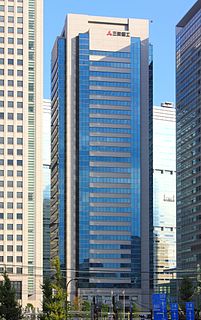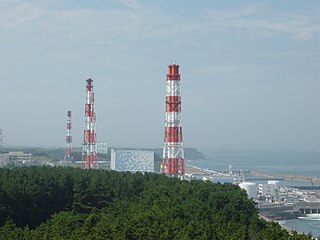
Naraha is a town located in Fukushima Prefecture, Japan. As of December 2014, the town had an official registered population of 7,098, and a population density of 68.5 persons per km2, although the current actual resident population is much lower. The total area of the town is 103.45 square kilometres (39.94 sq mi). From 2011 until 2015, the town was evacuated due to fallout from the Fukushima Daiichi nuclear disaster. While the town wasn't severely contaminated by the fallout, restrictions on residency were held until September 2015 when cleanup efforts concluded, allowing people to return. Naraha is the first of several towns and cities near Fukushima Daiichi Nuclear Power Plant to have been reopened to residents.

PackBot is a series of military robots by iRobot, an international robotics company founded in 1990. More than 2000 were used in Iraq and Afghanistan. They were then used again to aid searching through the debris of the World Trade Center after 9/11 in 2001. Another instance of the PackBot technology being implemented was to the damaged Fukushima nuclear plant after the 2011 Tōhoku earthquake and tsunami where they were the first to assess the site. As of November 2014, the U.S. Army is refurbishing 224 iRobot 510 robots. The PackBot technology is also used in collaboration with NASA for their rovers and probes.

Caesium-137, or radiocaesium, is a radioactive isotope of caesium which is formed as one of the more common fission products by the nuclear fission of uranium-235 and other fissionable isotopes in nuclear reactors and nuclear weapons. It is among the most problematic of the short-to-medium-lifetime fission products because it easily moves and spreads in nature due to the high water solubility of caesium's most common chemical compounds, which are salts.

Science and technology in Japan is mostly focused and prominent in consumer electronics, robotics and the film industry.
Atmea is a joint venture between Mitsubishi Heavy Industries (MHI) and EDF Group that develops, markets, licenses and sells the ATMEA1 reactor, a new generation III+, medium-power pressurized water reactor (PWR). The company is headquartered in Paris.

The Mitsubishi MH 2000 is a 7/12 seat light utility helicopter. Low levels of interest in the aircraft forced Mitsubishi to halt sales of MH2000 in September 2004.

Solar power in Japan has been expanding since the late 1990s. The country is a leading manufacturer of photovoltaics (PV) and a large installer of domestic PV systems with most of them grid connected. Japan has an insolation of about 4.3 to 4.8 kWh/(m2·day).
Arnold "Arnie" Gundersen is a former nuclear industry executive, and engineer with more than 44 years of nuclear industry experience who became a whistleblower in 1990. Gundersen has written dozens of expert reports for nongovernment organizations and the state of Vermont. His curriculum vitae shows Gundersen is a licensed Critical Facility Reactor Operator from 1971-1972.

The Fukushima Daiichi nuclear disaster was an energy accident at the Fukushima Daiichi Nuclear Power Plant in Ōkuma, Fukushima Prefecture, initiated primarily by the tsunami following the Tōhoku earthquake on 11 March 2011. Immediately after the earthquake, the active reactors automatically shut down their sustained fission reactions. However, the ensuing tsunami disabled the emergency generators that would have provided power to control and operate the pumps necessary to cool the reactors. The insufficient cooling led to three nuclear meltdowns, hydrogen-air explosions, and the release of radioactive material in Units 1, 2 and 3 from 12 to 15 March. Loss of cooling also raised concerns over the recently loaded spent fuel pool of Reactor 4, which increased in temperature on 15 March due to the decay heat from the freshly added spent fuel rods but did not boil down to exposure.

Fukushima Dai-ichi, is a multi-reactor nuclear power site in the Fukushima Prefecture of Japan. The Fukushima Daiichi nuclear disaster occurred after a 9.0 magnitude Tōhoku earthquake and subsequent tsunami on 11 March 2011, only 14 days before the reactor was to be shut down. This offshore earthquake, near the island of Honshu, produced a large tsunami in Japan, and a tsunami warning for over 20 countries within and around the Pacific Rim.
The Fukushima disaster cleanup is an ongoing attempt to limit radioactive contamination from the three nuclear reactors involved in the Fukushima Daiichi nuclear disaster which followed the earthquake and tsunami on 11 March 2011. The affected reactors were adjacent to one another and accident management was made much more difficult because of the number of simultaneous hazards concentrated in a small area. Failure of emergency power following the tsunami resulted in loss of coolant from each reactor, hydrogen explosions damaging the reactor buildings, and water draining from open-air spent fuel pools. Plant workers were put in the position of trying to cope simultaneously with core meltdowns at three reactors and exposed fuel pools at three units.

The Fukushima Daiichi nuclear disaster was a series of equipment failures, nuclear meltdowns, and releases of radioactive materials at the Fukushima I Nuclear Power Plant, following the Tōhoku earthquake and tsunami on 11 March 2011. It is the largest nuclear disaster since the Chernobyl disaster of 1986.

The Fukushima Daiichi nuclear disaster was a series of equipment failures, nuclear meltdowns, and releases of radioactive materials at the Fukushima I Nuclear Power Plant, following the Tōhoku earthquake and tsunami on 11 March 2011. It is the largest nuclear disaster since the Chernobyl disaster of 1986.

Investigations into the Fukushima Daiichi Nuclear Disaster began on 11 March 2011 when a series of equipment failures, core melt and down, and releases of radioactive materials occurred at the Fukushima Daiichi Nuclear Power Station from the 2011 off the Pacific coast of Tohoku Earthquake and tsunami on the same day.
The Sinop Nuclear Power Plant was a planned nuclear plant located at Sinop in northern Turkey. It would have been the country's second nuclear power plant after the projected Akkuyu Nuclear Power Plant.

Atlas is a bipedal humanoid robot primarily developed by the American robotics company Boston Dynamics, with funding and oversight from the U.S. Defense Advanced Research Projects Agency (DARPA). The 1.8-meter (6 ft) robot is designed for a variety of search and rescue tasks, and was unveiled to the public on July 11, 2013.












